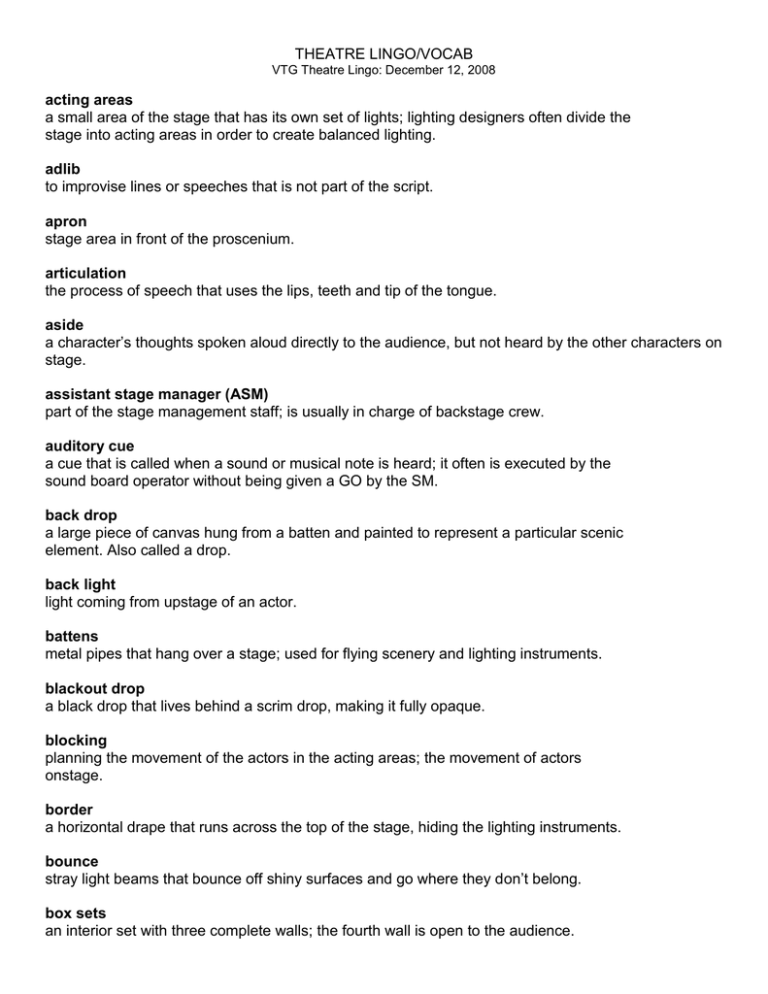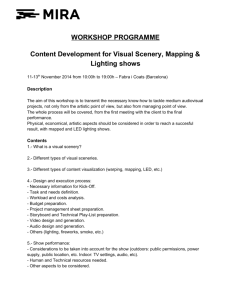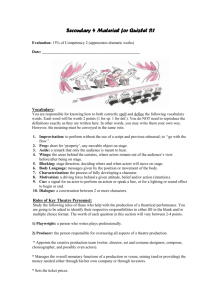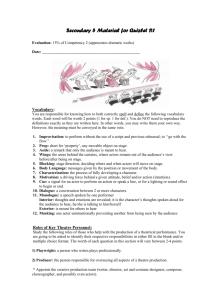Theatre Lingo
advertisement

THEATRE LINGO/VOCAB VTG Theatre Lingo: December 12, 2008 acting areas a small area of the stage that has its own set of lights; lighting designers often divide the stage into acting areas in order to create balanced lighting. adlib to improvise lines or speeches that is not part of the script. apron stage area in front of the proscenium. articulation the process of speech that uses the lips, teeth and tip of the tongue. aside a character’s thoughts spoken aloud directly to the audience, but not heard by the other characters on stage. assistant stage manager (ASM) part of the stage management staff; is usually in charge of backstage crew. auditory cue a cue that is called when a sound or musical note is heard; it often is executed by the sound board operator without being given a GO by the SM. back drop a large piece of canvas hung from a batten and painted to represent a particular scenic element. Also called a drop. back light light coming from upstage of an actor. battens metal pipes that hang over a stage; used for flying scenery and lighting instruments. blackout drop a black drop that lives behind a scrim drop, making it fully opaque. blocking planning the movement of the actors in the acting areas; the movement of actors onstage. border a horizontal drape that runs across the top of the stage, hiding the lighting instruments. bounce stray light beams that bounce off shiny surfaces and go where they don’t belong. box sets an interior set with three complete walls; the fourth wall is open to the audience. breakaway any scenery or prop designed to break on cue. calling a show the process of calling out the lighting, sound, and scene-change cues during a performance; usually done by the stage manager over a headset. calls announcements made backstage (usually by the stage manager) telling cast and crew how many minutes remain before the beginning of an act (15 minute call, 10 minute call, etc.). Also means the notice of the time of rehearsal or performance when the cast and crew must be at the theatre. catwalk an immobile platform above the stage that reaches from one end of the stage to the other, used to gain access to the stage equipment. C-clamp the metal clamp that holds a lighting instrument to the bar it’s hanging on; so named because of its C-like shape. center line an imaginary line down the center of the stage, from upstage to downstage. (used for constructing the set designs and building the set.) colour balance the overall colour of the light onstage. concept meeting one of the first meetings of the production period, where general concepts are hammered out. crossfade a lighting action in which a particular light cue fades down as the next light cue fades up. crossing (a cross) moving from one part of the stage to another, as an actor. cue (Q) something that happens at a particular point in the show, such as a change of lighting, scenery, or other technical event; also used to describe the verbal command to do that thing. The SM will call a lighting cue as “Lighting Q” or “LX” – either is acceptable. Sound cues are called as “Sound Q”. Lighting cues are usually numbered; sound cues are usually identified by a letter of the alphabet. cue-to-cue (Q to Q) a run-through of the performance with actors skipping dialogue and action from one technical cue to the next. curtain (curtain time) time set for the production to begin. Curtain line 1. The line on the stage floor where the front curtain touches when brought in. 2. The final line in the play. Also called the Tag Line. cyclorama (cyc) a large curved drop or wall used as a background to partially enclose the set. Quite often meant to resemble the sky. dialect distinctive sound of a culture, region or language. dimmer an electronic device to reduce the amount of power a lighting instrument receives, thereby reducing the intensity of light it is putting out. discovered a person or an object onstage when the curtain goes up. dressing a set the decoration of the set with items that are principally for aesthetic purposes only. drop a flat piece of fabric, generally painted, that forms part of the scenery. dry tech (paper tech) a technical rehearsal without actors electric a batten specifically used for lighting instruments. false perspective a scenic effect that, by exaggerating the effects of perspective, makes a set look bigger than it really is. first electric the most downstage electric; generally contains the greatest number of lighting instruments of any electric. flats vertical walls of scenery. flies the area above the stage that contains lines to be raised or lowered. floor plan the diagram showing the placement of the scenery as viewed from above. flying being raised up in the air. To “fly” a piece of scenery is to raise it up using ropes or cables. focus to direct and lock down a lighting instrument in its specified stage area. footlights strip lights used for general lighting. May be permanent or mobile. fourth wall an imaginary wall between the actors and the audience that disallows interaction between the two groups of people. Fresnel a type of lighting instrument that emits a soft-edged, diffused light. front-of-house (FOH) anything in the audience, e.g. lighting positions; also commonly used to describe staff (such as ushers, box office). front light any light coming from downstage of an actor. gel name for lighting colour filters (from the days when filters were made from animal gelatin). gel frame the metal frame that holds the colour filter within the lighting instrument. given circumstances information given about a character that the playwright has written into the script. glow tape tape that glows in the dark; placed in small pieces around the set so the actors and crew will not bump into anything during a blackout. ground plan (also called a floor plan) a technical drawing that indicates the position of scenery and set props on stage. hand props properties that are handled by actors during the performance. hanging the process of putting a lighting instrument in its designated spot according to the light plot. hot spot the center of a beam of light; the brightest part of the beam. house the part of the theatre where the audience sits. house left the left side of the auditorium, from the audience’s point of view. house lights lights used to illuminate the area where the audience sits. house right the right side of the auditorium, from the audience’s point of view. ingénue the young innocent female character; usually a love interest instrument a term used for any lighting device. iris the control on a follow spot that makes the circle of light bigger or smaller. knap a method of making sound to add effect to a staged punch. lamp the thing inside a lighting instrument that makes the light; often erroneously called a bulb. legs drapes that hang to the side of the stage, hiding the backstage area. Leko a particular brand of ellipsoidal spotlight. This term is often (and erroneously) used to describe any brand of ellipsoidal spot. light plot a drawn-up plan that designates the placement of lighting instruments relative to the set. light trees freestanding metal poles with wide bases; designed to hold lighting instruments. lighting (electrics) crew the crew members who hang, adjust, and operate lighting instruments. lighting cues the instructions that tell the lighting operators what to do and when to do it. musical director the person responsible for interpreting the musical score for voices and instruments. objective what a character wants; their goal. perspective to make a two dimensional space look three-dimensional. platform any horizontal playing surface, or a piece thereof. producer the person who organizes and facilitates production team; handles finances and communications. production team includes everyone who is actively involved in the production: heads of departments, such as stage manager, props manager, designers, producer, director as well as cast and crew. Sometimes used to refer to everyone involved in the production, except the cast; sometimes used to refer to Production Heads only. prompt book (prompt script) notebook which houses the stage manager’s script as well as forms, notes, blocking; contains all the pertinent information about the show. proscenium arch the architectural wall that separates the stage area from the audience. raked stage (rake) a stage that is slanted, either to increase visibility or to produce false perspective. read through an early rehearsal in which the script is read and discussed from beginning to end; designers may make presentations. rehearsal prop a prop that is used during rehearsal, substituting for the prop that will be used in performance. rendering a drawing or painting that shows what the set or costumes will look like. resonance enriches vocal tone by vibrations. royalties the fee that must be paid when using a copyrighted work. run through a rehearsal of the entire show (or an entire act) in order.. running crew the technical crew needed to operate a production; deck crew, costume crew, light board operator and sound operator are all positions on the running crew. running lights backstage lights that are dim enough to not affect the stage lighting but bright enough to allow cast and crew to move safely in the wings. Sometimes called “blue lights”. safety cable a cable that secures a lighting instrument to the batten. scrim a drop that can be opaque or transparent, depending on how it is lit. set designer the person responsible for planning the style, colours, textures, and arrangement of the physical environment. sides a side is a page of the script. soliloquy an interior monologue in which the audience overhears the character’s thoughts, motivations and reflections. spike to tape the position of the set and set props on the stage floor. spike tape coloured tape used to mark (or “spike”) scenery positions onstage. spill extraneous light that can be cut off with a shutter. stage crew the crew that works backstage during the show, shifting the scenery. stage makeup typically used to enhance an actor’s facial features that are washed out by the stage lighting. Also used to age a character, and for many special effects. stage manager the person who runs rehearsals, calls the cues during the show and, in general, is in charge of the technical aspects of the production. stage right the right side of the stage, from the actor’s perspective. stock scenery scenery that is stored and used for many different productions, e.g., flats and platforms. strike to remove any item from the stage. Also, to clear the theatre of all remnants of the show after the last performance. subtext the character’s thoughts; the hidden meaning underlining what the character’s saying. tactics various means an actor uses when pursuing a character’s objective. tape the stage the process of depicting the outlines of the set on the rehearsal room floor, using coloured tape; generally done by the stage manager before the first rehearsal. teaser a horizontal drape across the stage, designed to hide the first electric. technical director (technical advisor) the person who is responsible for maintaining technical equipment associated with play production, e.g., lighting instruments, sound equipment, headsets, etc. and will also recommend purchase of new and/or replacement equipment. technical rehearsal a rehearsal that includes technical effects, such as light, sound, scenery. template (pattern, gobo) a metal pattern that, when placed inside an ellipsoidal spotlight, throws a shadow pattern on the stage. upstage the part of the stage furthest from the audience. wash light unfocused, soft light that erases shadows and gives colour to a scene. wings the right and left sides of the backstage area.







